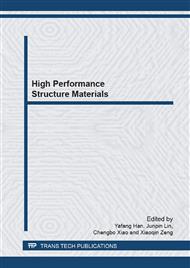p.25
p.31
p.38
p.44
p.50
p.57
p.63
p.69
p.77
Numerical Analysis of Superplastic Bulging Process of TiAl Sheet
Abstract:
The superplastic bulging process of TiAl sheet was simulated by coupling superplastic constitutive equation to finite element model. Based on this model, the effect of coefficient of friction between the sheet and mold and the size of the mold fillet on the superplastic bulging (SPB) performance of TiAl alloys sheet were studied by analyzing the evolution of equivalent plastic strain and thickness distribution in the sheet. The results showed that friction was the dominant factor of the nonuniform thickness of the sheet, while higher friction and smaller radius of mold fillet inhibited the over-thinning of sheet on the entry of mold cavity. The simulation results were in good agreement with the experimental results. Therefore, the present model could be used for optimizing the selction of the deformation parameters and the design of the structures.
Info:
Periodical:
Pages:
50-56
Citation:
Online since:
February 2013
Authors:
Price:
Сopyright:
© 2013 Trans Tech Publications Ltd. All Rights Reserved
Share:
Citation:


